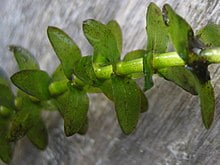Elodea

Elodea is a genus of 6 species of aquatic plants often called the waterweeds described as a genus in 1803. Classified in the frog’s-bit family (Hydrocharitaceae), Elodea is native to the Americas[1] and is also widely used as aquarium vegetation and laboratory demonstrations of cellular activities. It lives in fresh water.[3] An older name for this genus is Anacharis, which serves as a common name in North America.[4]
The introduction of some species of Elodea into waterways in parts of Europe, Australia, Africa, Asia, and New Zealand has created a significant problem and it is now considered a noxious weed in these areas.
Elodea canadensis, sometimes called American or Canadian water weed or pond weed, is widely known as the generic water weed. The use of these names causes it to be confused with similar-looking plants, like Brazilian elodea (Egeria densa) or hydrilla (Hydrilla verticillata). American water weed is an attractive aquarium plant and is a good substitute for Brazilian elodea. It can be used for science experiments in classrooms demonstrating how plants use carbon dioxide with the usage of bromothymol blue.
The American water weed lives entirely underwater with the exception of small white flowers which bloom at the surface and are attached to the plant by delicate stalks. It produces winter buds from the stem tips that overwinter on the lake bottom. It also often overwinters as an evergreen plant in mild climates. In the Autumn, leafy stalks will detach from the parent plant, float away, root, and start new plants. This is the American water weed’s most important method of spreading, while seed production plays a relatively minor role.[5]
Silty sediments and water rich in nutrients favor the growth of American water weed in nutrient-rich lakes. However, the plants will grow in a wide range of conditions, from very shallow to deep water, and in many sediment types. It can even continue to grow uprooted, as floating fragments. It is found throughout temperate North America, where it is one of the most common aquatic plants.[5]
